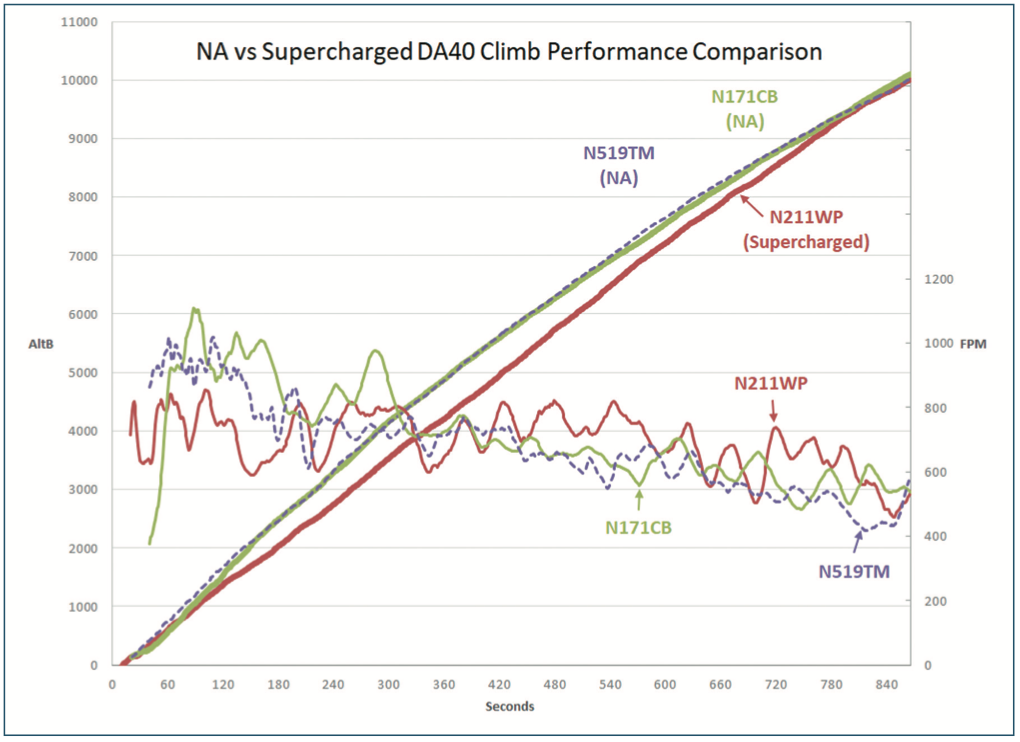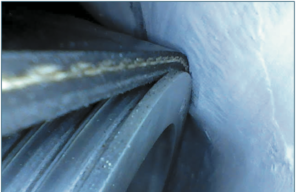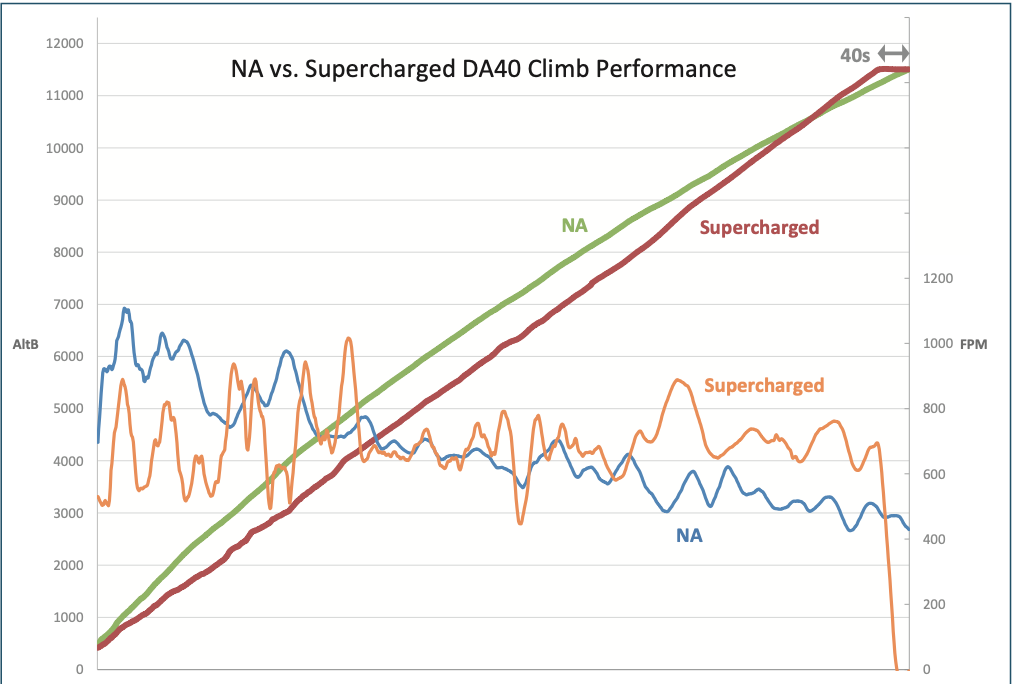In our May issue we reported on the supercharger STC offered by Forced Aeromotive Technologies (www.forcedaeromotive.com). It is a belt-driven (off of the accessory case) air compressor system that allows the engine to develop sea-level horsepower up to 7000 feet and 75 percent power as high as 12,000 feet. It’s offered for most Cessna 182s, Cirrus SR22s and Diamond DA40s.
We passed along comments and performance data from two aircraft owners—one of an SR22, the other of a DA40—who were quite satisfied with the mod.
In the wake of the article, we were contacted by a DA40 owner who was unhappy with the supercharger. He wound up removing the mod. His experience may be an object lesson for those considering aftermarket performance modifications for their aircraft—make sure the mod is designed for the type of flying you do, the way you fly your airplane and that you understand what the mod will and will not do.
BACKGROUND
Superchargers, and their exhaust gas-driven brethren, turbosuperchargers (turbos), have been increasing engine horsepower by compressing and shoving more air into the induction system for over a century. Because there’s no free lunch, when air is compressed it gets hotter. Hotter induction air means the engine runs hotter, and engine have heat limits. It’s not unusual for turbosupercharging systems to increase ambient air temperatures over 200 degrees in the compressor.
Rod Sage, founder of Forced Aeromotive, took a slightly different approach. Rather than compress intake air to the extent done in a turbocharger system—where you may get sea-level power as high as 20,000 feet—Sage used a relatively modestly sized supercharger that, according to Sage, increases induction air temperature by no more than 60 degrees.
Frankly, if the airplane has a turbo or supercharger, we expect to see higher CHT and oil temperatures. Historically, that’s not been a deal breaker for owners—they swarmed to turbocharging when it was introduced, and they put up with the increased maintenance associated as the cost of extra performance. Not only did it cost more to take care of an engine that ran hotter, maintenance time often increased as there was more “stuff” stuffed inside the cowling that could block access to other stuff.
THE AIRPLANE AND OWNER
Chris Bennett flies his Diamond DA40 about 350 hours a year. He is assertive in his maintenance practices and particularly his concern for his engine. He told us that he borescopes it at every oil change and follows recommendations made by General Aviation Modifications Inc. (GAMI) and others in the piston engine world that we respect to operate his aircraft so that cylinder head temperatures (CHT) do not exceed 400 degrees F at any time, including climb.

By contrast, and somewhat simplified, an aircraft manufacturer, or someone obtaining an STC, must demonstrate that the airplane will climb to designated altitudes, at designated speeds (including Vy), without exceeding redline CHT or oil temperature—for the DA40, that’s 500 degrees F for CHT and 245 degrees F for oil temperature. Data collected during cooling climb tests may be used for the climb performance information the manufacturer publishes. The raw test data is usually considered proprietary by manufacturers and not published.
The DA40 AFM calls for an airspeed of 66 KIAS at gross weight for best rate of climb and 73 KIAS for cruise climb.

In section 4A.4.10 “Mixture Adjustment,” there is a “Note” that reads: “For maximum service life cylinder head temperature should be kept below 435 degrees F (high performance cruise) and below 400 degrees F (for economy cruise).”
That section immediately follows the one titled “Cruise.” Section 4A.4.8 “Climb” does not contain any notes regarding CHT.
BUYING IN
Bennett told us that only about 4 percent of his flying time is above 10,000 feet; however, it is not unusual for him to go in and out of Lake Tahoe Airport, which has an elevation of 6268 feet. The DA40’s performance meant he usually was limited to morning departures and flying 150 pounds below gross. That, and a positive review by a DA40 owner who had installed Forced Aeromotive’s supercharging system, caused Bennett to make the decision to do so as well.

Bennett chose to have his mechanic do the install rather than go to Forced’s facility near Denver or Alpine Aviation in Grass Valley, Nevada, a shop that had done other installs. Things did not go smoothly: Notably a pulley on the drive belt rubbed against the modified cowling. After repeated conversations with personnel at Forced, Bennett took the airplane to Alpine, who fixed the clearance problem.
Bennett started flying his modified airplane and discovered that when climbing it at his self-imposed CHT limit of 400 degrees, the climb rate was no better than it had been before the modification. This led to a number of conversations between Bennett and Rod Sage of Forced. After speaking with both of them and reading long threads on the subject started by Bennett on various internet forums, we came to the conclusion that neither Bennett nor Sage is happy with the way things played out.
Bennett conducted a number of comparative climb tests, including using his airplane with supercharging and after it was removed and another DA40 with the supercharger mod. We have seen some of the data and have reproduced two graphs Bennett prepared. Bennett’s climb tests were not made at best rate of climb speed, but at whatever IAS was required to keep CHTs at or below 400 degrees F—he told us 85-90 KIAS. As a result, Bennett generally claims that the climb performance published by Forced is unrealistic.
Bennett also told us that he was unhappy with the modification because it was necessary to remove the spinner to do work on the engine and that it was sometimes necessary to remove supercharger assembly components to get to other areas.
Due to his dissatisfaction, Bennett removed the supercharger system and returned to normally aspirated operation.
When we spoke with Rod Sage, he told us that his company never got a chance to look at Mr. Bennett’s airplane. He pointed out that as a company obtaining an STC, he has to follow FAA requirements on testing. While Mr. Bennett’s data on climb performance while holding CHTs at 400 degrees may be accurate, that is not how the FAA requires climb testing be performed.
Sage also suggested that because the vast majority of Mr. Bennett’s operations are well below 10,000 that the supercharging mod is not the right fit for Mr. Bennett
OUR TAKEAWAY
Bennett’s experience reflected ours with boosted engines generally: To get the extra performance, you have to fly them per the manufacturer’s procedures. To get the published climb rate, or close to it, you have to fly it at the speeds called for in the POH or AFM—and accept the resulting CHTs. All you are guaranteed is that they will not exceed redline. We saw no evidence that climb performance published by Forced Aeromotive was in error. The owner of the modified DA40 we quoted in the May article reported climb rates of more than 800 FPM to 11,500 feet.
Mr. Bennett expressed concern about detonation margins when climbing with CHTs near redline. We certainly hear him on that topic and have the same concerns, but note that to obtain an STC, Forced Aeromotive had to show that the installation met FAA requirements to be free from detonation.
Bennett’s climb graphs did not show the IAS for each airplane. Based on our experience, the supercharged airplane was climbing at a higher IAS than the normally aspirated airplane to keep the CHTs at 400 degrees. Even though both airplanes arrived at 11,500 feet within forty seconds of each other, the supercharged one had undoubtedly traveled further.
We thought Mr. Barrett’s decision to install the supercharger STC to handle Lake Tahoe Airport was a good one. However, given his decision to limit his rate of climb so that he could keep CHTs at a limit he feels is prudent, we agree with his decision to remove the supercharging system.
Could he have known about the rate of climb at a 400-degree CHT limit ahead of time? That is not the sort of thing provided by any manufacturer. We think he could only have learned of it by flying a modified airplane.
Based on what we’ve learned about STC installs from readers and from Mr. Barrett’s experience, we are of the opinion that if an owner is going to have a complex STC installed, especially on the engine, she or he will be money ahead to have it done by the manufacturer, or a shop recommended by the manufacturer, and that has done it before—even if it involves a significant ferry distance. Remember the old aviation adages: Never buy the first model of anything—and never have a shop install something it’s never installed before.
BOTTOM LINES
We were part owner of a T210 for some years. We put up with a 500 FPM rate of climb to keep head temperatures below 400 degrees because it paid off once we got into the teens and could take advantage of the extra speed and tailwinds.
We think that anyone buying into a boosted engine has to be ready for some compromises in order to take advantage of its altitude capabilities—more expensive maintenance and dealing with problems associated with more heat in a more crowded cowling. We also think it means shelling out for an oxygen system, because we do not think that it’s worth the cost of the boosted engine if you can’t take advantage of what it can do.
If you do not need or want to fly above 10,000 feet on a regular basis, we doubt that supercharging or turbocharging is for you. However, if you do, because of terrain or you want to be able to get above more of the weather and have oxygen, we think it is a superb way to have more options available for any flight you make.





